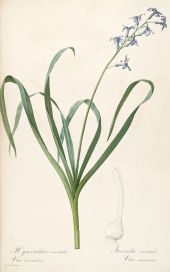Heady Hyacinths
By Audrey Stallsmith

If of they mortal goods thou art bereft,
And from thy slender store
Two loaves alone to thee are left,
Sell one, and with the dole,
Buy hyacinths to feed thy soul.
Musharish-Ud-Din Sadi
Like the camellia, the hyacinth was the quintessential Victorian "everyman's" flower. Its lushness of both fragrance and color, not to mention its affordability and ease of culture, made it the most popular bulb for forcing during that era. As Tovah Martin pointed out in Once Upon a Windowsill, hyacinth glasses even mimicked the hourglass figure that was in vogue at the time.
When hyacinths reached the height of their popularity, there were about 2000 cultivars available-including many opulent double-flowered varieties. Today, of course, that number has dropped drastically.
The hyacinth's squat, stiff shape and waxy flowers can make it appear artificial and out-of-place in the cheerful disorder of the cottage-type gardens we prefer now. But the bulbs are still very easy to force indoors. And, in the midst of a long gray winter, we can all use a splash of gaudy color and fragrance.
The hyacinth has two colorful myths attached to it too--both related to jealousy. Reportedly, the gods Apollo and Zephyr were both fond of a youth called Hyakinthos. One day when Apollo and the young man were playing at quoits, the jealous west wind misdirected one of the discuses throw by Apollo, so that it struck and killed Hyakinthos.
The flower that sprang from his blood is supposed to be etched with Apollo's cry of woe "ai". Although originally the flower of grief and mourning, hyacinth now stands for "game," "play," or "sport"-probably another reference to the quoits story.
Another fable holds that the plant sprang from Ajax's blood instead. Miffed that the weapons of the dead Achilles had been rewarded to Ulysses instead of himself, Ajax plotted murder. Sneaking into what he thought was Ulysses' camp, he commenced slaughtering right and left. With the return of daylight, however, he discovered to his chagrin that he had killed a flock of sheep instead. He reportedly committed suicide out of sheer embarrassment--perhaps with an "ai" of his own!
Since the English bluebell bears no trace of anybody's wail, it was called Hyacinthus nonscriptus ("not written on"). Today, it is sometimes known as Hyacinthus nutans. It also bears little trace of the heady hyacinth scent. Its odor is more "starchlike."
There may be a good reason for the lack of resemblance. Some think the Greek hyacinth was actually a fritillary, though the scent of fritillary is generally nothing to write home about either! On the other hand, the flower known in the Bible as "lily of the valley" may actually be hyacinth, since true lilies of the valley do not grow in the Holy Land.
Although poisonous, the bulb of Hyacinthus nonscriptus is, according to Gerard "full of a slimie glewish juice, which will serve to set feathers upon arrowes in stead of glew, or to paste bookes with: hereof is made the best starch next unto that of Wake-robin roots." That starch came in handy for stiffening the ruffs that were once popular men's wear. Mixed with wine and applied externally, hyacinth juice reportedly inhibited hair growth.
The grape hyacinth, Muscari racemosum, is supposed to have a similarly starchy smell although, in The Fragrant Path, Louise Beebe Wilder calls it "plumlike." And muscari actually derives from the Greek for "musk."
The feather hyacinth, Muscari comosum, has a soaplike substance, known as comisic acid, in its bulb. Although also poisonous, comosum was occasionally used as a diuretic and stimulant.
Our modern hyacinths are descendants of Hyacinthus orientalis, which probably originated in Turkey. Their unforgettable scent is, of course, their main claim to fame. Carl Sandberg wrote that poetry is the synthesis of hyacinths and biscuits--meaning, no doubt, a combination of the beautiful and the mundane. (Of course, the look and taste of fresh biscuits can be pretty darn heavenly too.)
At any rate, after the dreariness of winter, the sight and scent of hyacinths is as welcome as equally vivid Easter eggs!
Hyacinthus orientalis image is from Les Liliaces by P. J. Redoute, courtesy of the Missouri Botanical Garden








